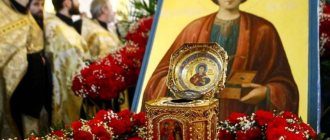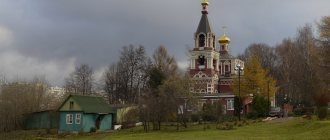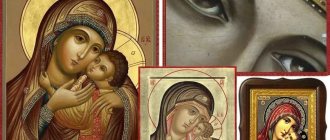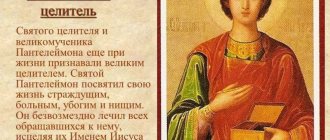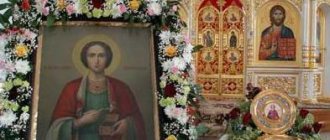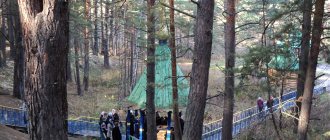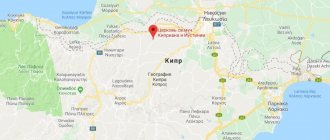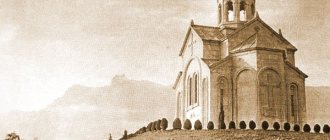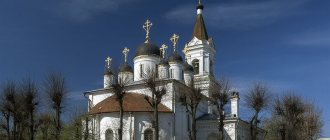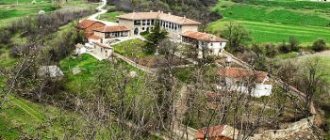Mir
Chapel of Panteleimon the Healer (Old Crimea) Map is loading...
{"format":"leaflet","minzoom":false,"maxzoom":false,"limit":50,"offset":0,"link":"all","sort":[""], "order":[],"headers":"show","mainlabel":"","intro":"","outro":"","searchlabel":"\u2026 \u0441\u043b\u0435\ u0434\u0443\u044e\u0449\u0438\u0435 \u0440\u0435\u0437\u0443\u043b\u044c\u0442\u0430\u0442\u044b","default":"","import-annotation":false,"width ":"auto","height":"350px","centre":{"text":"","title":"""link":"""lat":45.02060800000000284626366919837892055511474609375,"lon": 35.09698300000000159570845426060259342193603515625,"icon":""},"title":"","label":"","icon":"","lines":[],"polygons":[],"circles":[ ],"rectangles":[],"copycoords":false,"static":false,"zoom":8,"defzoom":14,"layers":["OpenStreetMap"],"image layers":[] ,"overlays":[],"resizable":false,"fullscreen":true,"scrollwheelzoom":true,"cluster":false,"clustermaxzoom":9,"clusterzoomonclick":true,"clustermaxradius":80, "clusterspiderfy":true,"geojson":"","clicktarget":"","showtitle":true,"hidenamespace":false,"template":"","userparam":"","activeicon": "","pagelabel":false,"ajaxcoordproperty":"","ajaxquery":"","locations":[{"text":"\u003Cb\u003E\u003Ca href=\"/palomnik/%D0% A7%D0%B0%D1%81%D0%BE%D0%B2%D0%BD%D1%8F_%D0%9F%D0%B0%D0%BD%D1%82%D0%B5%D0%BB% D0%B5%D0%B8%D0%BC%D0%BE%D0%BD%D0%B0_%D0%A6%D0%B5%D0%BB%D0%B8%D1%82%D0%B5%D0% BB%D1%8F_(%D0%A1%D1%82%D0%B0%D1%80%D1%8B%D0%B9_%D0%9A%D1%80%D1%8B%D0%BC)\» title =\»\u0427\u0430\u0441\u043e\u0432\u043d\u044f \u041f\u0430\u043d\u0442\u0435\u043b\u0435\u0438\u043c\u043e\u043d\u0430 \u042 6\u0435\u043b\u0438\ u0442\u0435\u043b\u044f (\u0421\u0442\u0430\u0440\u044b\u0439 \u041a\u0440\u044b\u043c)\»\u003E\u0427\u0430\u0441\u043e\u0432 \u043d\u044f \u041f\ u0430\u043d\u0442\u0435\u043b\u0435\u0438\u043c\u043e\u043d\u0430 \u0426\u0435\u043b\u0438\u0442\u0435\u043b\u044f (\u0421\u0 442\u0430\u0440\u044b\u0439 \u041a\u0440\u044b\u043c)\u003C/a\u003E\u003C/b\u003E\u003Chr /\u003E\u003Ca href=\"/palomnik/%D0%A1%D0%B2%D0%BE%D0% B9%D1%81%D1%82%D0%B2%D0%BE:%D0%90%D0%BD%D0%BD%D0%BE%D1%82%D0%B0%D1%86%D0%B8 %D1%8F\» title=\»\u0421\u0432\u043e\u0439\u0441\u0442\u0432\u043e:\u0410\u043d\u043d\u043e\u0442\u0430\u0446\u0438\u044f\»\u003E\ u0410\u043d\u043d\u043e\u0442\u0430\u0446\u0438\u044f\u003C/a\u003E: \u043d\u0430\u0445\u043e\u0434\u0438\u0442\u0441\u044f \u0443 [[\u0418\u0441 \u0442\u043e\u0447\u043d\u0438\u043a \u0441\u0432\u044f\u0442\u043e\u0433\u043e \u041f\u0430\u043d\u0442\u0435\u043b\u0435\ u0438\u043c\u043e\u043d\u0430 \u0426\u0435\u043b\u0438\u0442\u0435\u043b\u044f (\u0421\u0442\u0430\u0440\u044b\u0439 \u041a\u0440\u044b\u043c)|\u0441\u043 2\u044f\u0442\u043e\ u0433\u043e \u0438\u0441\u0442\u043e\u0447\u043d\u0438\u043a\u0430 \u0432\u0435\u043b\u0438\u043a\u043e\u043c\u0443\u0447\u0 435\u043d\u0438\u043a\u0430\ " title":"\ u0427\u0430\u0441\u043e\u0432\u043d\u044f \u041f\u0430\u043d\u0442\u0435\u043b\u0435\u0438\u043c\u043e\u043d\u0430 \u0426\u0 435\u043b\u0438\u0442\u0435\ u043b\u044f (\u0421\u0442\u0430\u0440\u044b\u0439 \u041a\u0440\u044b\u043c)","link":"""lat":45.020608000000002846263669198378920555 11474609375,"lon":35.09698300000000159570845426060259342193603515625,"icon": ""}],"imageLayers":[]}
Address:
Russia, Republic of Crimea, Kirovsky district, Old Crimea, st. Freedom
Chapel of Panteleimon the Healer
located at the holy spring of the Great Martyr Panteleimon the Healer.
History[edit]
Chapel of St. Panteleimon is an Orthodox chapel in the city of Stary Krym.
Dedicated to Saint Panteleimon, revered by believers as a healer and patron of healing. According to legend, the chapel was built in 1826 over a spring in which an icon of the saint was discovered.
The old chapel burned down in 1949.
In 2001, a new chapel was built with the money of parishioners.
The spring, whose water is considered healing, has also been preserved. Ksenia Tokareva, who moved to Old Crimea from Topel in 1958, looked after him for a long time.
Chapel of St. Panteleimon in old Moscow
| Epiphany Monastery on Nikolskaya Street. It housed the chapel of the Great Martyr. Panteleimon. Photo from 1883. |
In old Moscow, several hospital churches and the famous chapel in Kitai-Gorod on Nikolskaya Street, which stood opposite the Church of the Vladimir Icon of the Mother of God, were consecrated in the name of the Holy Great Martyr Panteleimon.
It was also destroyed by the Bolsheviks. The Holy Great Martyr Panteleimon lived at the end of the 3rd - beginning of the 4th centuries. from the Nativity of Christ. He was born in the Asia Minor city of Bethany, into a rich and noble family: the baby was named Pantoleon, which meant “a lion throughout.” His father was a pagan, and his mother, Saint Evvula, was a Christian and raised her son in the true faith, but died early. The father sent the boy to a pagan school, and then sent him to Nicomedia to study the art of medicine. In this city, Saint Panteleimon was to accept the crown of martyrdom for Christ.
Soon after completing his studies, the talented young man was introduced to the pagan emperor Maximian, who wanted him to remain as a court physician. At the same time, Saint Panteleimon secretly met Presbyter Ermolai, and every evening listening to his word about Christ, he himself believed. One day, returning home after a conversation, he saw a dead child on the road, who had died from the bite of an echidna, which was writhing nearby. Saint Panteleimon began to ask the Lord to resurrect his child and kill the viper, deciding that if his prayer was fulfilled, he himself would become a Christian. His request was fulfilled before his eyes, and he received Holy Baptism from Presbyter Ermolai. And then, after conversations with his son who believed, Saint Panteleimon’s father also converted to Christianity.
Having become a Christian, Saint Panteleimon continued to heal the sick, combining prayer with the gift of medical art. Through prayer to the Lord, he healed the suffering, the poor, the poor, and prisoners free of charge. Out of envy, other doctors reported to the emperor that Saint Panteleimon was a Christian and was treating Christians - it was a time of terrible pagan persecution. Maximian demanded that the saint make a pagan sacrifice, but instead he saw with his own eyes how Saint Panteleimon, through prayer, healed a paralytic. The wicked ruler, in a rage, ordered the healed man to be executed and Saint Panteleimon to be tortured. The martyr asked the Lord to strengthen him and heard an encouraging voice: “Do not be afraid, I am with you!” Having failed to achieve renunciation, the emperor ordered the death of Saint Panteleimon, but the sword suddenly became soft as wax, and the amazed soldiers exclaimed: “Great is the Christian God!” At this time, the Lord again revealed himself to the martyr and his executioners: a voice from heaven publicly called him “Panteleimon,” which means “much merciful.” Thus, shortly before his death, the martyr Pantoleon was given a new, true Christian name.
The soldiers refused to execute the saint, but he himself ordered them to carry out the order of the emperor - death befell him in 305. When his head was cut off, the blood sprinkled the olive tree, which blossomed and bore healing fruits. The saint's body was thrown into the fire, but turned out to be undamaged, and he was buried in Nicomedia.
The first churches in the name of St. Panteleimon appeared already in the 4th century in Constantinople and Sebastia of Armenia. In Rus', the great martyr was revered already in the 12th century. Grand Duke Izyaslav accepted Christian baptism under the name of Panteleimon and wore the image of the saint on his helmet - this once saved his life in battle. Under Peter I, on the feast of the Holy Great Martyr, the Russian army twice won victories in the Northern War - at Gangut in 1714, which was the first victory of the Russian fleet over the Swedes, and at Grengam in 1720. Two years later, the emperor ordered the construction of a temple in the name of St. Panteleimon in St. Petersburg.
Nowadays the honorable head of the saint rests in the Russian St. Panteleimon Monastery on Mount Athos, and his courtyard is open in the Nikitsky Church in Kotelniki near Taganka. Not long ago, the venerable relics of Saint Panteleimon were brought to Moscow and exhibited for veneration in the Novospassky Monastery for several days. In the Orthodox Church, Saint Panteleimon is called upon to help with the Sacrament of Anointing.
The foundation of the Moscow chapel was due to the fact that in 1866 the icon of the Mother of God “Quick to Hear” and with it other shrines were brought to Moscow from the Russian Panteleimon Monastery on Athos: particles of the holy relics of the healer Panteleimon, a holy cross with a particle of the Life-Giving Tree, part of the Tomb stone The Lord's. Hieromonk Arseny, who brought them to Moscow, stopped upon arrival at the Epiphany Monastery for men, and in its cathedral church the shrines were displayed for veneration. A great crowd of people gathered who wanted to venerate them, so that the temple was filled with people praying from morning to evening: healings were performed and performed, the good news about them spread around the city, and more and more people came.
Due to the huge number of pilgrims, in 1873 at the Epiphany Monastery, with the blessing of the Athonite elders, they built the Athonite Chapel for these shrines, on the same Nikolskaya Street. (Now in its place is a corner square at the intersection of Nikolskaya and Bogoyavlensky Proezd, since the building was demolished in 1929.) However, over time, the small chapel became cramped for everyone who wanted to venerate the shrines. Already in 1879 they began to think about building a new one.
And in 1880, the brother of the rector of the Athonite Panteleimon Monastery, hereditary honorary citizen Ivan Sushkin, donated a plot of his land for her to the monastery on Nikolskaya Street closer to the Vladimir Gate. A year later, construction began on a new chapel in the name of St. Panteleimon, with numerous donations from Muscovites. It was erected by the famous architect A. Kaminsky, son-in-law of the Tretyakov brothers, author of the neighboring Tretyakovsky Proezd arch. To commemorate the continuation of the tradition, he originally reproduced on the facade of his building the appearance of the facade of the old Athos Chapel.
The structure turned out to be very unusual for Moscow, since the chapel from the outside looked like a huge, majestic temple, of great height and impressive size. Now she could accommodate the multitude of worshipers who flocked to her and crowded in line at the chapel all day. There was another, purely architectural decision of the architect to create a new high-rise dominant on Nikolskaya Street, formed by a church building: in continuation of the historical tradition of building this area, where the bell towers and churches of the Epiphany, Zaikonospassky and Nikolsky monasteries rose. Now the new grandiose chapel dominated not only Nikolskaya alone, but also the entire Kitay-gorod, the largest business center of Moscow, in which tall “secular” buildings of commercial banks, insurance companies, and joint-stock companies were already being built.
In June 1883, the consecration of a new Moscow chapel, assigned to the Epiphany Monastery, took place, and Athos shrines were reverently transferred to it. It was considered one of the richest relics in Moscow: there was a miraculous image of the Savior, the icon of the Mother of God “Quick to Hear” and Iverskaya, the holy Great Martyr Panteleimon, the ark with holy relics.
The feast of St. Panteleimon was a Moscow celebration. Every year on July 27 (August 9), a procession of the cross departed from the chapel to the Epiphany Monastery. Nikolskaya was crowded with pilgrims, and so that all those praying could bow and venerate the miraculous icons, the images were taken out into the street on this day and placed under a special tent.
On ordinary days, Orthodox Muscovites went to the Panteleimon Chapel for blessed, healing lamp oil.
“For convict brands, For every illness, Baby Panteleimon, We have a healer,” -
Marina Tsvetaeva wrote about the chapel. They also went here for grace-filled spiritual help to the famous shepherd, rector of the chapel, Hieroschemamonk Aristoklius of Athos, who served here for many years. As a child, he himself suffered a serious illness - paralysis of his legs, until his mother made a vow to enter a monastery if her son was healed. Having become the rector of the Panteleimon Chapel, he not only spiritually nurtured his flock, but also helped the poor financially, obtained funds for the education of children from poor families, married off brides, accepted donations, and immediately transferred them to the poor. According to the testimony of his spiritual daughter, he predicted the Great Patriotic War and the future salvation of Russia by the Grace of God. According to his foresight, Father Aristoclius was buried at the Danilovsky cemetery. And after the death of the shepherd, a miraculous sign was revealed: when the coffin was being taken to the churchyard, a huge flock of pigeons, which Father Aristocles loved very much, flew in, and, circling, the birds formed a living cross in the sky. So they accompanied the priest to the grave.
Pilgrims from all over Russia gathered at the Panteleimon Chapel. Those suffering from blindness, epilepsy, obsession, mental disorders, bodily infirmities and mutilations hoped to find healing here and found it. And after the revolution, the icon of St. Panteleimon exuded a special power of grace, as if affirming the true faith in godless times. In 1927, shortly before the closure of the chapel, a miraculous healing of a sick Jew, Grigory Kalmanovich, from cancer took place here, and this miracle led him to believe in Christ and accept Holy Baptism. The disease was already at that stage that the doctors considered treatment useless and determined his remaining life to be two weeks. On the way from the clinic, Kalmanovich drove past the chapel and suddenly experienced an incredible desire to go into it. His wife tried to dissuade him from saying that this was a Christian church, but he still went into the chapel. There was a prayer service going on there. The patient knelt down in front of the image of the healer and stood in tears throughout the service, and then reverently kissed the icon and experienced incredible relief - the pain was released and he felt healthy. When doctors examined him again, they found no traces of the disease. Without saying a word about his prayer, the healed man returned home and immediately went to the local church, where he told this story to the priest - and joyfully accepted the Christian faith.
| Church of the Resurrection in Sokolniki |
After the revolution, the authorities banned the miraculous image of St. Panteleimon from being taken out into the street on holidays.
The chapel was closed in 1932 and two years later was broken down along with the fortress wall of Kitai-Gorod, but the Grace of God preserved almost all of its shrines for Moscow. The miraculous image of the Savior is located in the Church of Saints Florus and Laurus on Zatsepa (see August 31), the icon of the Mother of God “Quick to Hear” was transferred to the Church of Saint Nicholas the Wonderworker in Klenniki on Maroseyka, Iverskaya - to the Church of the Sign in Pereyaslavskaya Sloboda (near metro station "Rizhskaya" ). The miraculous image of the holy great martyr Panteleimon himself and the ark with holy relics from his chapel are now in the famous Church of the Resurrection in Sokolniki. So, fortunately, the priceless Moscow shrine was not lost. House hospital churches with altars in the name of the Great Martyr Panteleimon were located at the Bakhrushinsky hospital on Stromynka (now named after Ostroumov), in the Mariinsky shelter on Donskaya Street, set up for the care of elderly sick women of noble origin, and in the Medvednikovsky hospital behind the Serpukhov outpost.
All of them were closed after the revolution.
Cross Hermitage and the Holy Spring of the Great Martyr and Healer Panteleimon on the map
Address of the monastery "Cross Hermitage" : Russia, 354538, Krasnodar region, Sochi, Lazarevsky district, Solokhaul village, Koshmana street, no. 10.
You can book an individual excursion to Solokh-Aul, which includes a visit to all the sights of Solokhaul: the Koshman estate, the Holy Cross Hermitage, an observation deck over the Shakhe River and Koryta on the Western Dagomys River.
© Website “On the Roads of the Middle Way”, 2009-2021. Copying and reprinting of any materials and photographs from the site anashina.com in electronic publications and printed publications is prohibited.
As a place of pilgrimage
We have been to the source several times, each time there is a dilemma - to drive closer to it or leave the car on the side of the road. It would be nice if the local authorities paid attention to the path to the spring from the Ibresi-Kanash highway. Considering that this is a local landmark, it could have been covered with asphalt, especially since it is only 500 meters from the road.
There are some concrete slabs thrown into one lane, so it’s difficult to pass oncoming traffic, especially if it’s raining, snowing, or muddy roads. If you leave your car near the highway, you won’t get much water. I had to drive closer. There is a chapel and an indoor bath there. To get water you need to go down the steps.
However, it has always been believed that the more difficult the pilgrim’s path, the more God will reward him. Previously, people walked to holy places, and sometimes on their knees or crawling. Therefore, we will consider all these difficulties as just another small test. And we must always remember that the most important thing is not to visit a holy place, not to get water, but our feelings and thoughts. It is advisable to become a “saint” near such places, at least for a second.
Think about God, about the salvation of the soul, about the eternal. Previously, getting to holy places was difficult purely physically, problems with traffic and logistics and purely physical fatigue. Now that visiting such places has become a business and a lot of infrastructure has been built everywhere: hotels, shops, tents. You will be transported on a comfortable bus. Sometimes there are a bunch of different icons, pieces of holy relics, and water of various sizes and packages for sale nearby.
Moreover, the service is often very intrusive. It is very difficult to switch to maintaining peace and reverence when this stream of pilgrimage industry is falling on you from all sides. And against this background, a visit to a modest spring flowing next to Ibresi seems simply the apotheosis of simplicity and purity. I went down the steps, got some water, dragged it up, there was nature all around, the birds were singing. Such an atmosphere of kindness and purity is created, you want to forgive the sins of yourself and others.
Properties of spring water
It should be noted right away that water is not “holy”, that is, it spoils if it is stored for a long time in a closed vessel. Holy water will be available for some time in the winter after Epiphany frosts or if a product made of real silver is dipped into it. Therefore, local people simply use water from Surbeevka for drinking and cooking.
But you can swim there, there is an enclosed space, a swimming pool. This will be nice in warm weather. It is believed that it is necessary to take a dip in clothes and preferably for men and women separately. It is better to fast and confess the day before, and read a prayer before washing. After the procedure, you must also say a word of thanks to the Lord. You can address the Lord in your own words, the main thing is that they come from the heart, for example, “Give me health so that I can pray fervently until the end of my days.”
For convenience, the text of the prayer to the Great Martyr Panteleimon hangs on the wall of the bathhouse. A prayer said over water miraculously changes its properties; in addition, it affects the biorhythms of the brain and changes consciousness, active mental activity slows down and a person programs himself for health and longevity. Nearby there is a board with rules of behavior at the place of manifestation of God's special mercy.
How to get there
Getting to the source is quite easy. Syurbeevka is located almost next to Ibresy. If you go towards the city of Kanash, then on the right side there will be a sign where you need to turn. The road, as I wrote above, is not very good, but you can get through it. If you are not going to get a lot of water, then you can leave the car on the side of the road or drive off a little and take a walk. It is less than 1 km, but in the fall it will probably be difficult for elderly and not entirely healthy people to walk through the muddy roads.
By car it takes 5 - 10 minutes from Ibresi, on foot - an hour or half an hour, depending on where you go. Buses and minibuses pass by there, but since the bus station is only 2 km from the source and you still need to get to it from the other end of the village, this issue needs to be studied specifically. Because it is often the final stop, but sometimes something goes further.
Trees around the holy place
First of all, these are willows, which can be called the green symbol of Chuvashia. Vetla, belotal, white willow, yamra are a traditional symbol of the Chuvash village. For as long as I can remember, villages had very wide streets lined with willows. They grow along ravines and river banks, protecting slopes from landslides and soil erosion after melting snow and rainfall.
These giants, who can be 100 years old, protected houses from fires. Baskets and fences were made from flexible branches. Various utensils, children's crafts, and whistles were made from soft wood. Rooks made nests in the treetops. A wonderful honey plant, bees circle during flowering. The willow symbolizes resilience, perseverance, optimism and the encouraging threshold of survival of the Chuvash people.
Willow growing by the ravine is a beauty. Below is a silvery cold stream, She bashfully rinses her braids in it, She shelters rooks in her leaves.
And at noon no one will hear him, but the rooks fly and scream loudly. As soon as it became dark in the evening, the moon appeared and the stars were shining.
And my soul felt calm and warm. The cold spring flows and flows. Lo and behold, he made it through, we were lucky! The water is as clear and clear as ice
Flows through a ravine, it flows into a pond Along the bank of the willow, others grow One - a touch-me-not with a curly braid, An old woman with old brown bark
The willow strands of branches sway. The mirror wrinkles, our pond freezes. And the souls of dead people seem to come, coming to see how the children live. author Nikolaeva M. R.
Elms also grow there, of which there are many in the Sura River basin and surrounding forest areas. It is either smooth, khurama or rough elm. The trees are honey plants, frost-resistant, durable. From a mythological point of view, the elm was considered a “male” tree, and the willow was considered a “female” tree. Sacred elms were considered a connecting link between the “upper” and “lower” worlds. It was not customary to plant elm near the house.

